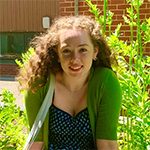It may be hard to put your finger on it, but Duke often allows students to connect their classes to something more personal.
The university’s emphasis on interdisciplinary education is a major initiative that colors students’ academic experiences. While there are many examples of these connections between people, classes, fields, and departments, few so tangibly represent those connections like The SCOPES Project, which connects arts and humanities to medical education at Duke.

Art and medicine can exist in entirely different worlds. They can appeal to different people and tell different stories. But why be simple when you can be, well… stunning? They can be integrated to form something powerful, and that’s precisely what SCOPES leadership members Isa DeLaura, Raluca Gosman, Mason Seely, David Stevens, and Lindsay Olson aimed to do.
“It is encouraging as an upperclassman who previously participated in this program to see rising students continue the tradition of incorporating the humanities into medical practice,” Mason Seeley says. The generational aspect of the project seems to contribute to its personality; participants bring their own perspectives to their work only to walk away with dozens more.
“Having a creative outlet has helped me process interactions with patients and the difficulties of the profession, and celebrate happy moments as well,” says Isa DeLaura.
“The goal is to give artists creative freedom to explore their relationships with their patients with whatever medium and in whatever style works best for them. As such, every year the feel is entirely based on the decisions of the artists.”
Isa DeLaura, MS3+
David Stevens insists that the artists “resist… forces of depersonalization in compelling and beautiful ways.”
The project is inspired and supported by yet another interdisciplinary Duke initiative called APPLE (Appreciating Patient Perspectives through Longitudinal Encounters), which connects medical students with patients living with chronic illnesses. The artists/medical students/empaths-in-training then attended multiple creative workshops and developed art pieces to reflect their patients’ personal experiences. But this year’s 6th annual SCOPES exhibition looks a bit different from past years’ (which are conveniently available online for your viewing pleasure).
Having attended many an art opening myself, I am unashamed to say that much of my enjoyment comes from the cheeseplates (and the excitement in the air, but that’s besides the point). Some exhibitions opt for a traditional charcuterie, some marked Kirkland Signature and others displayed on a handmade butcherblock. The point of fingerfoods is to encourage the attendees to stand up, walk around, and interact with the masses. But it also encourages attendees to “just stop by,” making the affair all the less intimate.
Following limitations on group gatherings Duke enforced during COVID, the SCOPES team decided to apply their newfangled interdisciplinary/revolutionary/innovative thinking to the art opening itself: They held a banquet.
“I loved the way this turned out,” says DeLaura. “It was very personal and made for great discussion and comradery.”
“SCOPES has provided an opportunity to reflect on my experiences as a first-year medical student while also exploring new ways to combine various art forms to create my vision,” says Taylor Yoder, who created Fences, Rivers, Walls, pictured above. “I hope to continue shooting film throughout my medical education and career.”
I was particularly (although wrongfully) surprised about the variety in the exhibit. While the artists attended the same workshops and worked with patients through the same program, they took radically different approaches to their creations. Esme Trahair, a second-year medical student, was a humanities major in undergrad. Her piece combines historical perspectives with modern (although antiquated) mechanisms, emphasizing “the importance of remembering and learning from historical, outdated medical teachings.”
The work features a variety of perspectives, but also some clear motifs that could be key takeaways for future medical providers. Like Yoder, artist Kreager Taber explores the patient’s value of “home.” Exploring these motifs could allow for more personal, “upstream” healthcare.
This year’s SCOPES exhibition is held in the Mars Gallery in the Duke University Hospital Concourse. It is an initiative of the Trent Center for Bioethics, Humanities & History of Medicine at the Duke University School of Medicine. It will be on display August 9-September 29, and available for viewing online at this link.
P.S. If you are an MS1 student interested in participating in SCOPES, I have a link for you!

Post by Olivia Ares, Class of 2025
